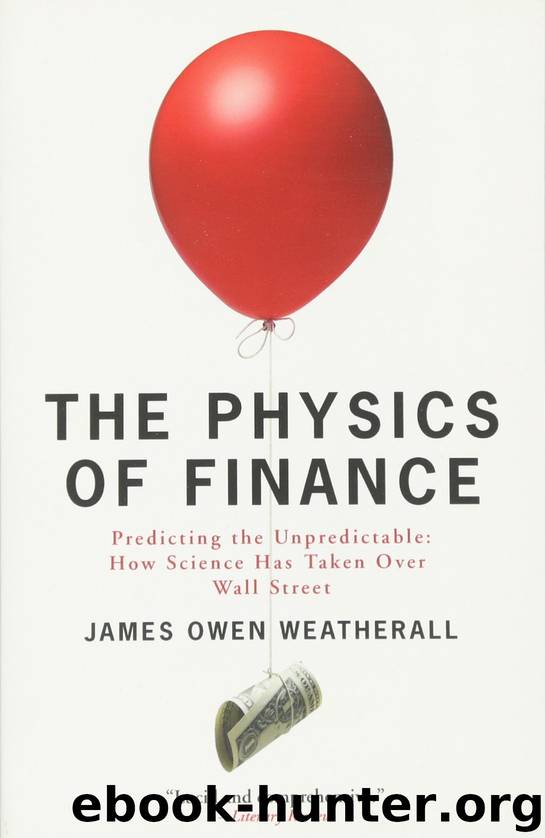The Physics of Finance by James Owen Weatherall

Author:James Owen Weatherall [Weatherall, James Owen]
Language: eng
Format: epub
ISBN: 9781780720876
Google: ofjOoAEACAAJ
Amazon: 1780720874
Publisher: Short Books Ltd
Published: 2014-09-14T16:00:00+00:00
One theme that characterized much of the research in complexity and chaos during the early 1980s was the idea that simple large-scale structures can emerge from underlying processes that don’t seem to have that structure. To take an example from atmospheric physics, consider that the atmosphere, at the smallest scale, consists of a bunch of gas particles bumping around in the sky. And yet, when one steps back, these mindless particles somehow organize themselves into hurricanes. Similar phenomena occur in biology. Individual ants seem to behave in pretty simple ways, foraging for food, following pheromone trails, building nests. And yet, when one takes these simple actions and interactions in aggregate, they form a colony, something that appears to be more than the sum of its parts. As a whole, an ant colony even appears to be able to adapt to changes in its environment, or the deaths of individual ants. Once these ideas were in the air at Santa Fe, it was a natural leap to ask if the economies of nations and the behavior of markets could also be understood as the collective action of individual people.
The Santa Fe Institute hosted its first conference on economics, entitled “International Finance as a Complex System,” in 1986. Farmer, who at this point was the head of the Complex Systems research group at Los Alamos, was one of a small handful of scientists who were asked to speak. It was his first exposure to economics. The other speakers were from various banks and business schools. These bankers stood up and explained their models to a group of stunned scientists who found the financial models almost childishly simple. The bankers, meanwhile, walked away thinking that they had heard the siren call of the future, though they had virtually no understanding of what was being said. Excited, they urged the institute to host a follow-up conference and invite various luminaries from economics departments at top universities.
The idea behind the second conference was that even if the financiers couldn’t follow the latest advances in physics and computer science, surely the professional economists would be able to. Unfortunately, things didn’t go as planned. Farmer and Packard both spoke, as did various other Santa Fe Institute researchers. The economists, likewise, made their presentations. But there wasn’t much communication. The two groups were coming from two radically different cultures and taking too many different things for granted. The physicists thought the economists were making everything much too simple. The economists thought the physicists were talking nonsense. The great synthesis of disciplines never occurred.
Undeterred, the institute tried a third time in February 1991. This time, though, the economists stayed at home. Instead, the institute invited practitioners from the banks and investment houses that actually ran the world’s financial markets. The tone of the conference was much more practical and focused on how to create models, test them, and use them to develop trading strategies. The traders proved much less defensive than the economists, and by the end of the conference each group had gained an appreciation of what the other had to offer.
Download
This site does not store any files on its server. We only index and link to content provided by other sites. Please contact the content providers to delete copyright contents if any and email us, we'll remove relevant links or contents immediately.
International Integration of the Brazilian Economy by Elias C. Grivoyannis(75675)
The Radium Girls by Kate Moore(11636)
Turbulence by E. J. Noyes(7717)
Nudge - Improving Decisions about Health, Wealth, and Happiness by Thaler Sunstein(7261)
The Black Swan by Nassim Nicholas Taleb(6784)
Rich Dad Poor Dad by Robert T. Kiyosaki(6194)
Pioneering Portfolio Management by David F. Swensen(6089)
Man-made Catastrophes and Risk Information Concealment by Dmitry Chernov & Didier Sornette(5672)
Zero to One by Peter Thiel(5505)
Secrecy World by Jake Bernstein(4405)
Millionaire: The Philanderer, Gambler, and Duelist Who Invented Modern Finance by Janet Gleeson(4115)
The Age of Surveillance Capitalism by Shoshana Zuboff(4001)
Skin in the Game by Nassim Nicholas Taleb(3978)
The Money Culture by Michael Lewis(3857)
Bullshit Jobs by David Graeber(3847)
Skin in the Game: Hidden Asymmetries in Daily Life by Nassim Nicholas Taleb(3736)
The Dhandho Investor by Mohnish Pabrai(3573)
The Wisdom of Finance by Mihir Desai(3538)
Blockchain Basics by Daniel Drescher(3341)
